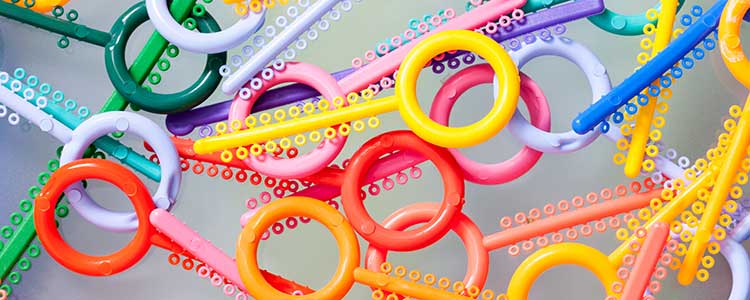One of the most common ‘adjuncts’ or additional tools that orthodontists use to straighten your teeth are orthodontic elastics or rubber bands.
While there are several options for correcting the relationship of the upper and lower sets of teeth (i.e. headgear, springs, functional appliances, surgery, etc.), the most common method is elastic bands. They are used to apply pressure to the jaw to correct the alignment of your bite and reduce overbite/underbite. They can be applied in a number of configurations, but the most common is inter-arch (from the top to the bottom).
Benefits of elastics
Elastics are not as noticeable as other options (like headgear). They are usually tooth coloured so that they blend in with the teeth (although they also come in bright colours that kids love!).
A great feature of elastics is that they are stretchy and flexible. This allows patients to maintain a full range of motion during talking, yawning, and other normal jaw functions. They are also easy for patients to remove and replace. This allows elastics to be replaced daily and facilitates eating and brushing.
Elastics are often chosen by orthodontists as they can be used to correct most types of bite problems such as overbites, underbites, open bites, and crossbites. Few other devices are as versatile. And, as a bonus, elastics are more cost-effective than other gadgets available for bite correction.
What do elastics do?
While brackets, archwires and ligatures are responsible for moving teeth along the gumline and the angle at which they point away from the gums, elastic bands pull the jaw forward or backwards in order to line up your top and bottom rows of teeth to improve your smile and make your teeth fit together comfortably when you bite down. They are also often used to accelerate the process of moving or straightening a tooth or teeth.
To accomplish this, brackets with hooks are placed along the side of the mouth. A band is attached on each side of the mouth – from one hook/bracket to the other. The angle of the band depends on how much pressure is required to fix the over or underbite.
How and when to wear your elastics?
You should follow directions carefully when wearing rubber bands for dental treatment. In most cases, you should wear your elastics 24 hours a day. Some dental professionals say that the only times you can take them out are to eat, floss or brush. This should be mentioned as it is true that wearing elastics 100% of the time is unrealistic in some cases as it is difficult for some people with certain elastic configurations to open their mouth wide enough to eat.
It is in your best interest to wear your elastics as much as possible with the exception of eating and brushing. You should also wear your elastics while sleeping. Though this may cause some discomfort, committing to wearing your elastics as much as possible will help your treatment run on schedule.
Depending on the strength/thickness of the elastics and what your day-to-day activities are, you may need to replace them 3-4+ times every day so you should keep a pack of them on you at all times. It is also advised to change them at least once a day. This is necessary even if they do not break as they tend to lose elasticity and strength over time. Your orthodontist will advise you accordingly.
